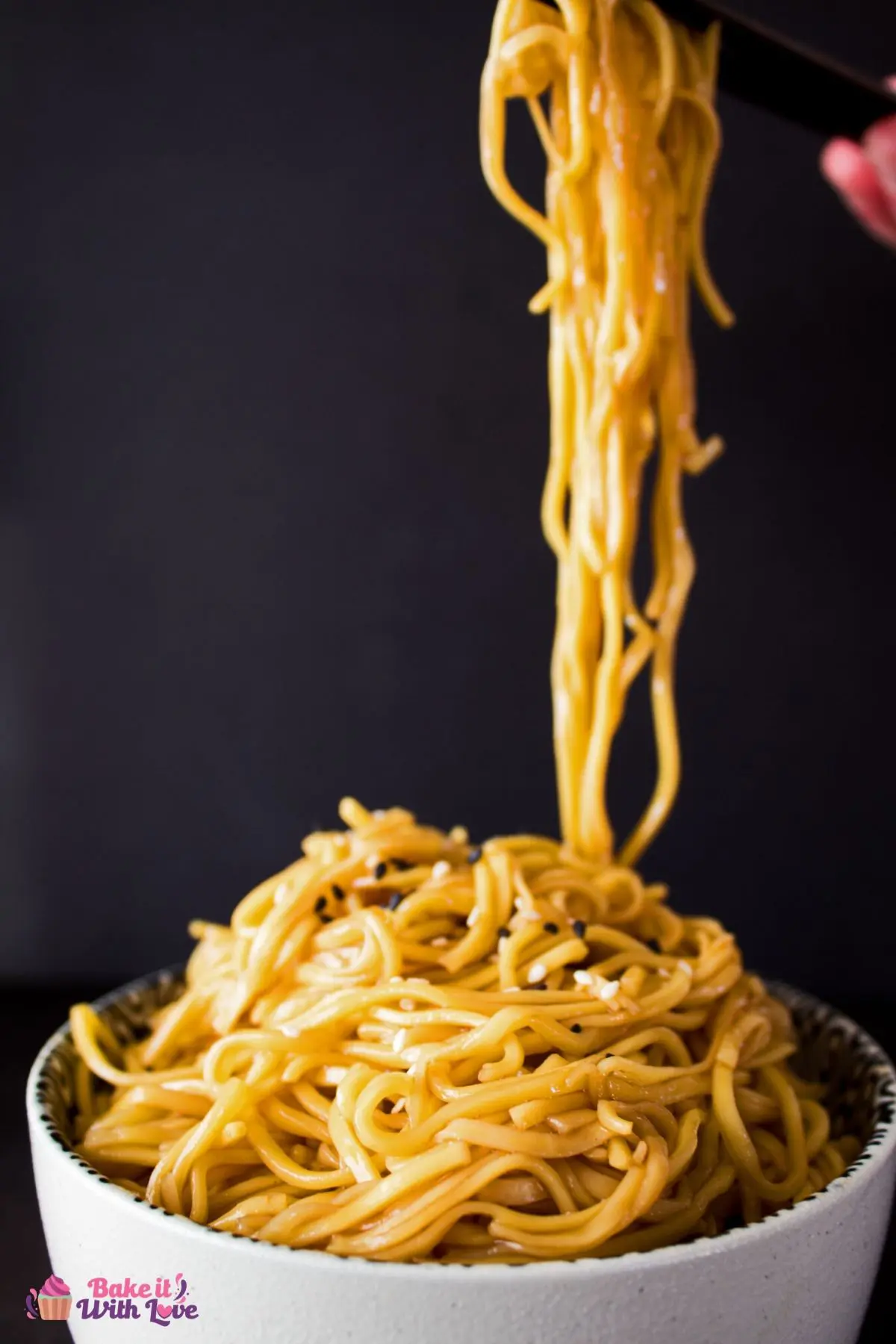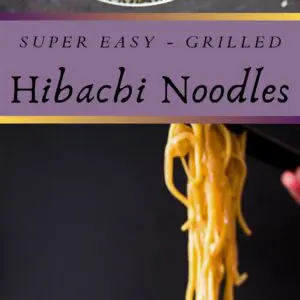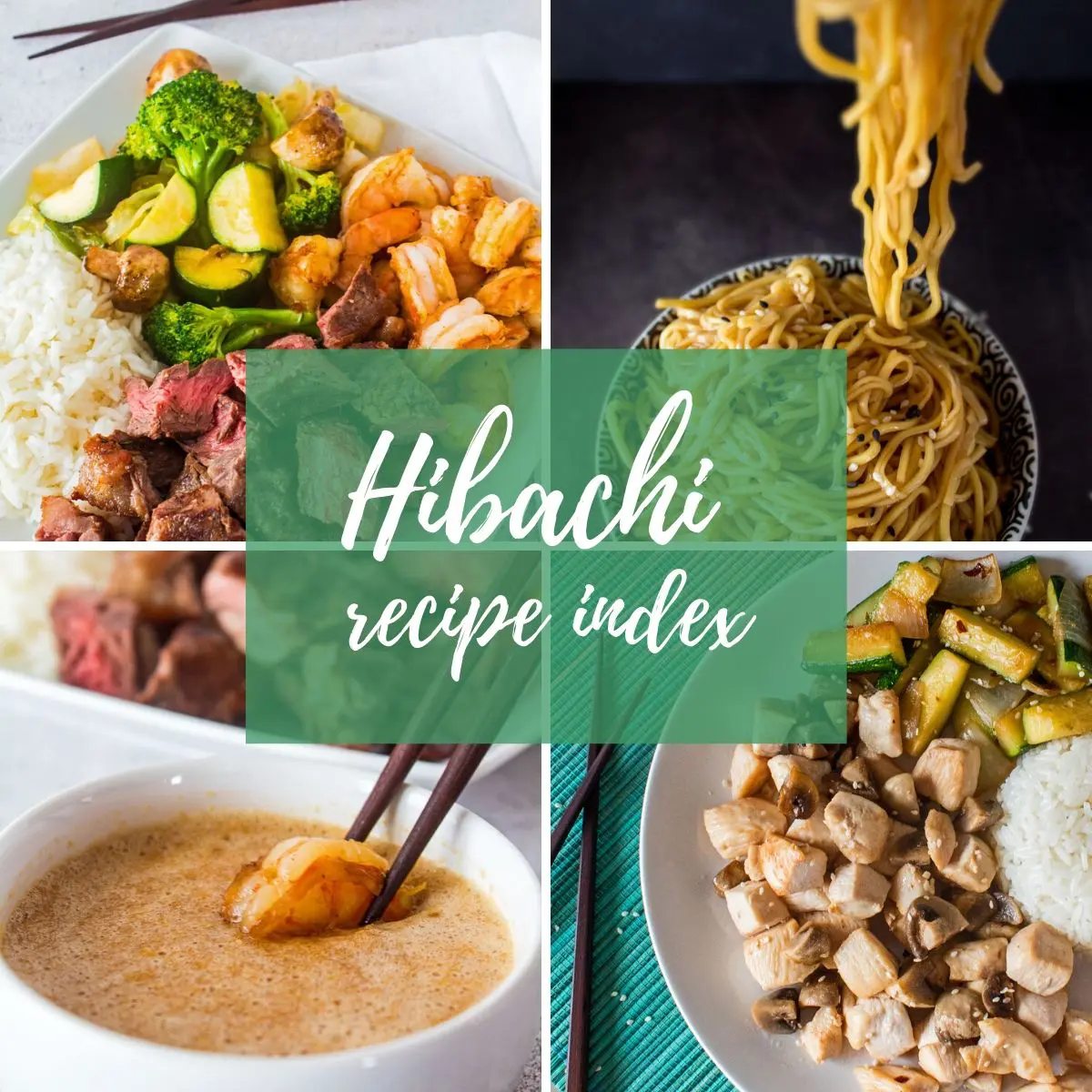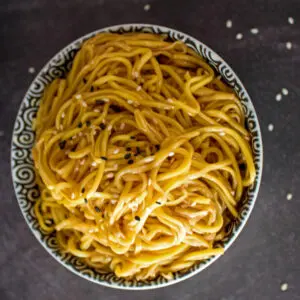Unleash the flavors of Japan with my easy Hibachi noodles recipe! Learn to cook this savory, classic dish at home and impress your family and friends. Sear these tasty noodles off using a grill top griddle after cooking your meats so that the noodles pick up that 'just grilled' taste from your hibachi chicken, beef, or seafood!

Jump to:
Hibachi Noodles: Japanese Steakhouse Noodles
If you don't know just how addictive these grilled Hibachi Noodles are yet, you are missing out!
I'm a big pasta fan anyway, but hibachi noodles are extra special coming straight off a grill and coated in a rich, buttery, silky smooth sauce flavored with soy and teriyaki sauce. Plus, a drizzle of my favorite addition, mirin.
The cooking experience is one of the most memorable parts of dining at a Japanese steakhouse, but the next best thing is making these delicious noodles at home!
If you love hibachi teppanyaki cooking, try my other amazing Japanese steakhouse recipes! Hearty hibachi steak and shrimp, fried vegetables, zucchini, and more!
Make your homemade hibachi noodles a meal by grilling your favorite vegetables and a protein, then tossing them with the noodles for a loaded noodle bowl!
My family's hibachi grilling night usually includes these perfect grilled noodles or hibachi fried rice, plus some hibachi vegetables and one of the three staples in our home (steak, chicken, pork, or shrimp).
We love our dipping sauces, too, so it's always a debate between yum yum sauce, creamy mustard sauce, and ginger sauce (best served with seafood and vegetables).
❔ What Are Hibachi Noodles?
Hibachi noodles are those fabulous soft, fried garlic noodles served at Japanese steakhouse restaurants like Benihana, Kyoto, and Kobe.
The noodles (or rice or vegetables) are cooked near your desired protein on the grill, which picks up some of the flavors and meat juices from cooking on the same grill!
🥘 Ingredients
- Yakisoba Noodles, Lo Mein, or Angel Hair Pasta - (see additional notes below on traditional Japanese noodles used for hibachi cooking)
- Sesame Seed Oil - used to coat the noodles after draining and in the hibachi cooking oil blend.
- Fresh Ground Black Pepper - a couple turns of your grinder for freshly ground pepper; otherwise, just a pinch of ground pepper.
- Hibachi Cooking Oil - (See the Hibachi Cooking Oil section below) is the primary sauce used to fry the noodles.
- Unsalted Butter - would work best. I hold off on adding soy sauce or salting my noodles.
- Garlic - finely minced garlic that will be sauteed in the butter before adding the noodles.
- Ginger - finely minced ginger that will be sauteed in the butter before adding the noodles.
- Teriyaki Sauce - part of the final flavor of your hibachi noodles. Add more to taste if desired (see my homemade teriyaki sauce recipe).
- Mirin - (optional - but I love and highly recommend it!
- Sesame Seeds - optional, for garnish when serving.
Be sure to see the free printable recipe card below for ingredients, exact amounts & instructions with tips!
🥢 How To Make Hibachi Cooking Oil
The base cooking oil used by hibachi chefs combines 4 basic ingredients. Hibachi cooking oil is made with sesame oil, olive oil, rice cooking wine, and soy sauce.
Combine the oils, rice cooking wine, and soy sauce in a sealable container such as a jar or squeeze bottle for easy storage and use. Shake to combine before using.
If you don't have sesame oil, you can read about the best sesame seed oil substitutes in my guide here!
🔪 How To Make Hibachi Noodles
Cook your chosen pasta noodles until al denté in texture. Drain and rinse, then drizzle with sesame seed oil.
Season with a few turns of your fresh black pepper grinder (or a pinch of ground pepper) and toss the noodles to coat evenly. Set aside.
Fry The Noodles
- Heat. Bring the wok or a large frying pan to medium heat. Add ¼ cup of the hibachi cooking oil, butter, garlic, and ginger.
- Fry. Sauté the garlic and ginger while the butter melts until the garlic is tender, about 2-3 minutes. Add the pasta, teriyaki, and mirin. Fry the cooked noodles until they are heated through, turning occasionally, for about 2 minutes.
- Serve. Use additional hibachi cooking oil as needed, then sprinkle with sesame seeds when serving.
This is as close as I have gotten to 'authentic' hibachi noodles, authentic in this case being as close to my favorite Japanese steakhouse's just-fried noodles.

🍜 What Kinds Of Noodles Are Best For Hibachi Grilling?
Note that there is no one actual 'hibachi noodles' that you can purchase. The name 'hibachi noodle' comes from the cooking style that is seen.
They are usually cooked with quite a bit of flair displayed by the chefs (we had a chicken shape made out of egg for our daughter that was chopped up and added to the hibachi rice).
- Yakisoba - (meaning 'fried buckwheat' and referring to the Chinese noodle chūkamen, which is not technically a true Soba noodle) are the noodles you see in the photos used here.
- Harusame is clear, glass noodles based on mung bean starch.
- Somen - thick, white noodles that are wheat-based and hand-pulled.
- Udon Noodles are thick, white noodles made from buckwheat flour, most known for being served in the fish and kelp-based broth, dashi.
- Soba is pale yellow noodles made from wheat flour and buckwheat.
- Ramen Noodles are pale yellow noodles made from eggs, wheat, and Kansai (mineral-rich water that lends to the color of these noodles).
- Rice - gluten-free white noodles made of rice.
- Shirataki - clear, chewy noodles made from konnyaku.
- Hiyamugi is white, wheat-based noodles similar to udon or somen noodles.
- Tokoroten - clear, jelly-like noodles made of kanten gelatin from Japanese (ogonori) red seaweed.
Chinese Lo Mein noodles are a good substitute that is typically easy to find. Also, standard pasta such as Spaghetti, Linguine, and Angel Hair pasta can be used.
>>>See All Of My Tasty Recipes Here!<<<
🥡 Storing & Reheating
Refrigerate unused hibachi noodles in an airtight container for up to 3 days. They are best used within the first day or two, so I don't recommend serving them after 2 days of being refrigerated.
Reheating
A quick stovetop heating is the best way to reheat your leftover noodles (as well as pretty much any take-out or homemade Chinese or Japanese-style foods).
Heat a large skillet or wok on high heat, use a touch of my hibachi cooking oil, and turn noodles for about 2 minutes or until heated through completely.
Check out my fabulous hibachi recipes for making an incredible hibachi dinner night at home!
❓ Recipe FAQs
A hibachi is a Japanese grill called a shichirin. It is a small, portable barbecue grill typically made with cast iron. Foods are cooked on a grate over an open flame, commonly with charcoal as the heat source.
U.S. hibachis are made for indoor cooking, so they often have an electric heating source rather than an open flame.
If hibachi grilling is done over a grate, what cooking style is done at the Japanese steakhouses we all love?? The iron griddle flat cooking surface, also done over an open flame (most commonly fueled with propane), is teppanyaki-style.
Both styles grill food over an open flame, but hibachi grilling is done over a grate surface, and teppanyaki grilling is done on a griddle surface.
When thinking of the tasty hibachi noodles made at your local restaurant, the most commonly used noodles are yakisoba noodles.
Soba, ramen, udon, and somen noodles are all great choices for making restaurant-style hibachi noodles.
Do you love a recipe you tried? Please leave a 5-star 🌟rating in the recipe card below and/or a review in the comments section further down the page.
Stay in touch with me through social media @ Pinterest, Facebook, Instagram, or Twitter! Subscribe to the newsletter today (no spam, I promise)! Don't forget to tag me when you try one of my recipes!
📖 Recipe Card
Hibachi Noodles
Ingredients
Hibachi Cooking Oil
- 1 tablespoon sesame seed oil
- 2 ½ tablespoon olive oil (extra virgin)
- ¼ cup rice cooking wine
- 2 tablespoon soy sauce
Hibachi Noodles
- 1 lbs yakisoba, lo mein or angel hair pasta (cooked al dente)
- 1 tablespoon sesame seed oil
- fresh ground black pepper
- 3 tablespoon butter (unsalted)
- 1 ½ tablespoon garlic (minced)
- 1 tablespoon ginger (minced)
- 1 tablespoon teriyaki sauce
- 1 tablespoon mirin (or 2 tablespoon sugar)
- sesame seeds (optional, garnish)
(Note: 2x or 3x only changes the ingredient list)
Instructions
Hibachi Cooking Oil
- Combine ingredients in a jar or squeeze bottle that you can seal with a lid to shake up the contents, and for storing any unused portion (if desired).
- Shake container before using to cook hibachi style foods, such as these hibachi noodles, rice, vegetables, chicken, steak, or seafood.
Hibachi Noodles
- Cook, drain and rinse noodles. Drizzle with sesame seed oil, then lightly season with a couple turns of your black pepper grinder (or sprinkle with a pinch of ground pepper). Toss noodles and set aside.
- In a wok or large frying pan, bring the wok to medium heat. Add ¼ cup of the hibachi cooking oil, butter, garlic and ginger.
- Saute the garlic and ginger while the butter melts and until the garlic is tender, about 2-3 minutes. Add the pasta, teriyaki, and mirin. Fry the noodles until they are heated through, turning occasionally, for about 2 minutes.
- Use additional hibachi cooking oil as needed, sprinkle with sesame seeds when serving.
Notes
- To store: Refrigerate unused hibachi noodles in an airtight container for up to 3 days. They are best used within the first day or two, so I don't recommend serving them after 2 days of being refrigerated.
- To reheat: A quick stovetop heating is the best way to reheat your hibachi noodles (and pretty much any take-out or homemade Chinese or Japanese-style foods). Heat a large skillet or wok on high heat, use a touch of my hibachi cooking oil, and turn noodles for about 2 minutes or until heated through completely.





Sam says
Best hibachi noodles I've made, seriously just like my local Japanese restaurant!
Daisy says
Hello Angela, these hibachi noodles were really good as is. I was wondering if you had any suggestions for sauce recipes that would go good with these noodles?
Angela @ BakeItWithLove.com says
I usually serve mine with some more teriyaki sauce, but you can also use my stir-fry sauce to make the noodles. Other ideas to add would be a touch of hoisin sauce, that sweet chili sauce, chili paste, Yoshida's brand teriyaki sauce, or a tiny bit of sriracha for heat.
Tina says
Fantastic noodles, perfect with my hibachi steak!
Jena says
These were a hit! I too couldn’t find the rice cooking oil, all sold out in every store I went! But they were still amazing.
Question- I’m headed to a beach house so I’m trying to prepare everything in advance with leds prep work. Is there any way I can make the sauce, refrigerate it and then heat it up while I’m there, cook the noodles then toss? Would save so much time measuring and cooking for me!
Angela @ BakeItWithLove.com says
Definitely make the sauce and chill it, then store it until ready to use over your beach trip. Enjoy!!
-edited to add, that your sauce will warm when tossed with fried noodles. 🙂
Amanda C says
These were simply the best hibachi noodles that I have ever made! We've used the electric skillet, blackstone, and a large frying pan to cook these up. They have never been a disappointment!!
Steph says
This recipe was fantastic! I omitted the rice cooking wine as I didn't have any. I made the noodles 2 hours ahead of time and stored them in the fridge. Then cooked them in a skillet with a tad more soy sauce after we cooked our chicken&veggies to add in. Then tossed everything together. The noodles tasted like our Hibachi grill in town! They were delicious! I'm saving this recipe, for sure!
Anonymous says
What did you use in place of the rice cooking wine?
Angela @ BakeItWithLove.com says
The best substitute is another Asian cooking wine (Shaoxing Wine) or cooking Sherry or another dry white wine, or omit it entirely. Hope that helps!
Tracee Pettee says
I just got done printing all your wonderful Hibachi recipes! Can't wait to try them all!
Angela @ BakeItWithLove.com says
They are wonderful, I really hope you enjoy them as much as I do!
Sherri says
Where do you purchase Yakisoba noodles? Do you have a link?
Angela @ BakeItWithLove.com says
Normally I can find them in a local Walmart in the produce section. It can be difficult to find so try these on Amazon. *This is an affiliate link, it doesn't cost you any more to follow this link and purchase these noodles.
Maria S says
Wonderful, just like eating at our favorite Japanese hibachi restaurant. The noodles were fantastic with your chicken recipe! Keep up the good work.
Angela @ BakeItWithLove.com says
Thank you, I love hearing that! Glad to hear that you enjoyed the noodles and chicken!!
Jenny says
Love this easy recipe, I am making this and your hibachi steak for dinner tonight I will let you know how it turns out I am so excited!
Brandy says
Thank you for the hibachi cooking oil! This is exactly what I needed for cooking hibachi dinners at home!
Chris R. says
Thanks so much for your information on reheating these noodles.
Amanda says
How long can you store the hibachi cooking oil?
Angela @ BakeItWithLove.com says
Hello Amanda, since the 4 hibachi cooking oil ingredients are all long-lasting when stored you can easily store your oil in the refrigerator. I usually use mine within a couple of weeks, but would say that 2-3 months refrigerated in a sealed container is a safe storage time. Hope that helps and thanks for asking!
Amber says
Is the rice cooking wine the same as rice vinegar?
Angela @ BakeItWithLove.com says
Hello Amber! No, the rice cooking wine and rice vinegar are different in flavor and the vinegar will add an acidic flavor. The best substitute is another Asian cooking wine (Shaoxing Wine) or cooking Sherry or another dry white wine.
Dani Y says
Great list of noodles I can use for my hibachi dinner
Debbie says
I cannot find rice cooking wine....
Angela @ BakeItWithLove.com says
If you cannot find rice cooking wine, a cooking sherry or white wine (dry) will also work. Hope that helps!
Steph says
I omitted the rice cooking wine and it still tasted great! 🙂